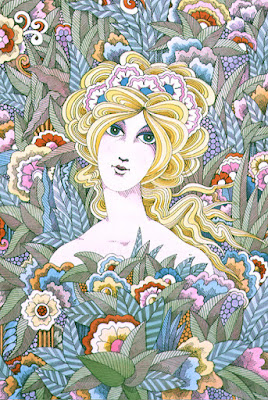I didn't set out to have back-to-back early 1970s nostalgia illustration posts, but while I was out and about today, I came across this display of illustrations by John Alcorn:
I had never heard of him before that moment, but I immediately had one of those childhood-based visceral reactions to the look of his work. Here's a close-up of the parts that resonated the most:
The accompanying text says the framed pieces are from the 1966 book The Fireside Book of Childhood Songs by Marie Winn. I don't know if I saw that book specifically back in the day, but the colors and the style are so familiar. Maybe it was other people imitating him on greeting cards or other places rather than his own work. There's no way for me to know.
Did he design it? I don't know.
John Alcorn was part of Push Pin Studio in its earliest days, then later was at CBS, until he had a successful career as a freelance illustrator. His work was on a huge number book covers, many on European-language books from the looks of the work shown on this site.
He also did some highly visible commercial work in the U.S.:
That curved-baseline type below the image is so badly set... I wonder if it was part of the original design?
This illustration was used on the Eve cigarette package (and Alcorn also did detail work that was printed on the filters of the cigarettes themselves):
The last piece I'll post is a bit bizarre, or at least the product seems to have been. I vaguely recall its existence. I don't think it was very successful:
Alcorn died young, at the age of 57, in 1992.
I'll be posting about him again, because I couldn't resist ordering a copy of The Fireside Book of Childhood Songs and another book he illustrated that I discovered while I was looking around, which has images from that same era of his work.
___
Alcorn isn't the first Push Pin illustrator I've mentioned. Here's a past post about Emanuel Schongut.













4 comments:
I remember his illustrations very well -- not that I knew his name, but I know I've seen lots of his work.
His work looks like it must have something to do with Yellow Submarine, or vice versa, but I don’t see anything about that in the Wikipedia articles for him and for the film. Was it all just in the air?
It was definitely in the air. This gallery article describes how Peter Max consulted on the film, then recommended the German artist Heinz Edelmann to the Beatles. He was calling himself “The German Peter Max.”
In the article, Max is quoted as saying the film's look was “similar in some ways to my ’60s art but even more similar to Pushpin Studios artists Milton Glaser, Seymour Chwast and John Alcorn.”
https://www.parkwestgallery.com/peter-max-and-the-beatles/
Thanks for that background, DN3.
Post a Comment